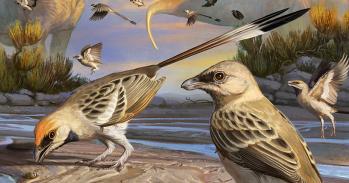
Fish embryo study indicates that the last common ancestor of vertebrates was a complex animal complete with gills – overturning prior scientific understanding and complementing recent fossil finds. The work places gill evolution concurrent with shift to self-propulsion in our earliest ancestors.
Fish embryo study indicates that the last common ancestor of vertebrates was a complex animal complete with gills – overturning prior scientific understanding and complementing recent fossil finds. The work places gill evolution concurrent with shift to self-propulsion in our earliest ancestors.
Our work suggests that the physiological innovation of gills occurred at the same time as the lifestyle transition from passive to active in some of our earliest ancestors
Andrew Gillis
A new study has revealed that gills originated much deeper in evolutionary history than previously believed. The findings support the idea that gills evolved before the last common ancestor of all vertebrates, helping facilitate a "lifestyle transition" from immobile filter-feeder to actively swimming predator.
The research, published today in the journal Current Biology, shows that gills develop from the same embryonic tissue in both jawed and jawless vertebrates - a lineage that split very early in our ancestral tree.
Jawed vertebrates - such as fish, birds and mammals - make up 99% of all living vertebrates, including us. Jawless vertebrates include the parasitic lamprey and scavenging hagfish: eel-like creatures that diverged from the ancestral line over 400 million years ago.
Previous work in this area involved slicing thin sections of fish embryos to chart organ growth. These "snapshots" of development led scientists to believe that gills were formed from different tissues: the internal 'endoderm' lining in jawless vertebrates, and the 'ectoderm' outer skin in the jawed.
As a result, since the mid-20th century it was thought that the ancient jawed and jawless lines evolved gills separately after they split, an example of 'convergent evolution' - where nature finds the same solution twice (such as the use of echolocation in both bats and whales, for example).
Biologists at the University of Cambridge used fluorescent labelling to stain cell membranes in skate embryos, and tracked them through the dynamic development process. Their experiment has now shown that the gills of jawed vertebrates emerge from the same internal lining cells as their jawless relatives.
The researchers say this is strong evidence that gills evolved just once, much earlier in evolutionary history - before the jawless divergence - and that the "crown ancestor" of all vertebrates was consequently a more anatomically complex creature.
The findings pull the invention of gills closer to the "active lifestyle" shift in our early ancestors: the evolution from passive filter feeders to self-propelled ocean swimmers. Scientists say that gill development may have been a catalyst or consequence of this giant physiological leap.
"These findings demonstrate a single origin of gills that likely corresponds with a key stage in vertebrate evolution: when some of our earliest relatives transitioned from filtering particles out of water pumped through static bodies to actively swimming through the oceans," says lead author Dr Andrew Gillis, a Royal Society University Research Fellow in Cambridge's Department of Zoology, and a Whitman Investigator at the Marine Biological Laboratory in Woods Hole, US.
"Gills provided vertebrates with specialist breathing organs in their head, rather than having to respire exclusively through skin all over the body. We can't say whether these early animals became more active and needed to evolve a new respiratory mechanism, or if it was gill evolution that allowed them to move faster.
"However, whether by demand or opportunity, our work suggests that the physiological innovation of gills occurred at the same time as the lifestyle transition from passive to active in some of our earliest ancestors."
While the jawed vertebrate lineage spawned the majority of vertebrate life that exists on Earth today - "evolutionarily speaking, we are all bony fish," says Gillis - lamprey and hagfish are the living remnants of a once extensive assemblage of primitively predatory jawless vertebrates.
"Lamprey are eel-like parasites that use their tooth-like organs and raspy tongue to latch onto fish and suck out the blood, while hagfish scavenge by taking bites out of dead matter," he says.
Gillis and colleagues used embryos of the little skate to track early gill development through cell tracing. The skate is a cartilaginous fish - an early-branching lineage of jawed vertebrates that includes the sharks and stingrays.
This made skate an excellent comparison point to try and infer the primitive anatomical and developmental conditions in the last common ancestor of jawed and jawless vertebrates.
The embryonic work of the Gillis laboratory neatly complements paleontological research from their Cambridge colleague Prof Simon Conway Morris, who has spent much of his career studying fossils of the Cambrian period of rapid evolution - when most major animal groups originated.
In 2014, Conway Morris was part of the team that discovered Metaspriggina: one of the oldest-known vertebrate fossils, perhaps over 500 million years old, which displayed hints of a gill structure, as well as the muscle arrangement of an active swimmer.
"Our embryological research helps us understand exactly how the gill structures in early vertebrates such as Metaspriggina relate to the gills of living forms," says Gillis.
"Embryology can tell us about the evolutionary relationship between anatomical features in living animals, while palaeontology can pinpoint precisely when these features first appear in deep time. I think that this work nicely illustrates how these two areas of research can inform one another."

The text in this work is licensed under a Creative Commons Attribution 4.0 International License. For image use please see separate credits above.




